Gardening enthusiasts often encounter the frustrating problem of cats using their potted plants as a litter box. As a cat owner and avid gardener, I understand the challenges this behavior presents. In this article, I will share effective strategies and techniques to prevent cats from pooping in your beloved plant pots.
Key Takeaways:
- Use cat litter or deterrents to discourage cats from using plant pots as a litter box.
- Understand cat behavior to better address the issue.
- Establish boundaries and consistency to prevent cats from accessing the pots.
- Discipline cats using positive reinforcement and redirecting techniques.
- Consult a vet for behavior issues and consider the impact of diet on cat behavior.
Understanding Cat Behavior
Before we can effectively address the issue of cats pooping in potted plants, it’s essential to gain a deeper understanding of cat behavior. As feline pet owners, we must recognize that cats have natural instincts and behaviors that drive their actions. By understanding these behaviors, we can develop strategies to modify their behavior and prevent them from using our plant pots as a litter box.
Cats are territorial animals, and marking their territory is a natural behavior for them. This territorial marking can include using specific areas for elimination, such as plant pots. Additionally, cats are creatures of habit and prefer consistency in their environment. Understanding these innate behaviors helps us pinpoint the reasons why cats engage in this unwanted behavior and allows us to address the issue more effectively.
Another important aspect of cat behavior to consider is the role of potty training and the litter box. Cats are generally fastidious animals that prefer clean and private spaces for elimination. If your cat is not properly potty trained or if there are issues with the litter box, they may seek alternative areas, such as your plant pots, to do their business.
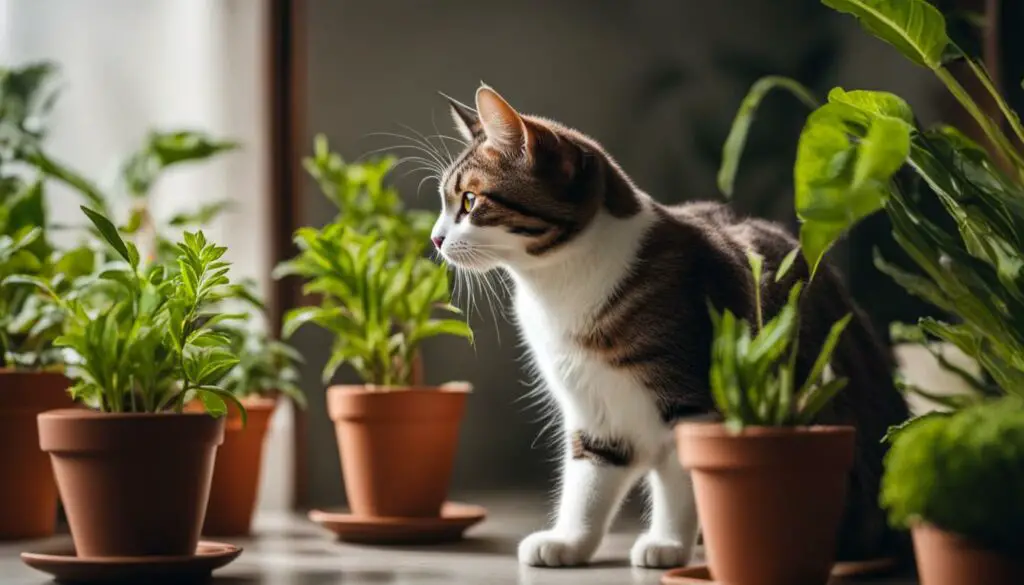
By delving into the intricacies of cat behavior and understanding the factors that contribute to cats pooping in potted plants, we can develop targeted strategies to address this issue. In the following sections, we will explore various techniques, boundaries, and discipline methods that can help deter cats from using our beloved plants as their personal litter box.
Recognizing Common Cat Behavior Problems
Understanding cat behavior is crucial when it comes to addressing the issue of cats pooping in potted plants. By recognizing common cat behavior problems, we can develop effective strategies to prevent this unwanted behavior. Let’s take a look at some of the behaviors that may contribute to cats using plant pots as their litter box.
Inappropriate Scratching
One common behavior that cats engage in is inappropriate scratching. Cats have a natural instinct to scratch, which helps them stretch their muscles, mark their territory, and shed the outer sheath of their claws. However, when cats scratch furniture or other inappropriate surfaces, it can be frustrating for pet owners. Providing cats with designated scratching posts can redirect their scratching behavior and discourage them from using plant pots as a scratching surface.
Territorial Marking
Cats are territorial animals, and they have various ways of marking their territory. One of these ways is through urine marking, which involves leaving small amounts of urine in specific areas. If cats perceive your potted plants as part of their territory, they may use them as a place to mark. Neutering or spaying cats can help reduce territorial marking behaviors, as can providing them with a consistent and clean litter box environment.
The Use of Catnip
Catnip is a plant that contains a chemical called nepetalactone, which can have a euphoric effect on cats. While many cats enjoy the experience of playing with catnip, some may become overly excited and engage in behaviors such as rolling, scratching, or even eliminating in inappropriate places. Monitoring your cat’s reaction to catnip and limiting access to it can help prevent cats from using potted plants as their litter box.
Table: Common Cat Behavior Problems
| Behavior Problem | Description |
|---|---|
| Inappropriate Scratching | Cats scratching furniture or other surfaces instead of designated scratching posts. |
| Territorial Marking | Cats using urine to mark their territory, including potted plants. |
| The Use of Catnip | Cats engaging in excited behaviors after exposure to catnip, including eliminating in inappropriate places. |
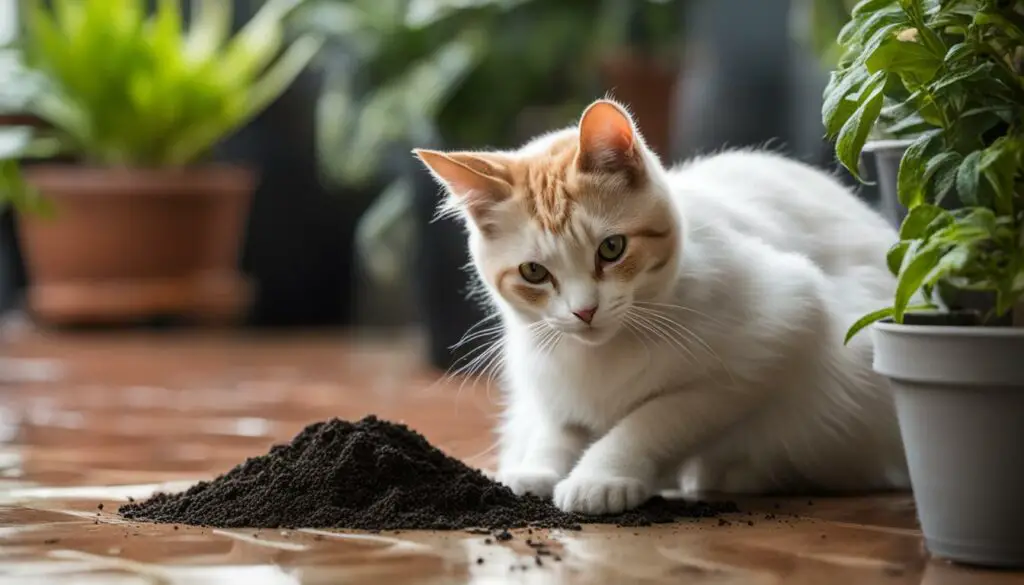
By recognizing these common cat behavior problems, we can take proactive steps to prevent cats from using potted plants as their litter box. Providing appropriate scratching surfaces, creating a clean litter box environment, and monitoring catnip exposure can all contribute to modifying cat behavior in a positive and effective manner.
Establishing Boundaries
Creating clear boundaries is crucial when it comes to preventing cats from using your potted plants as a litter box. Consistency is key in enforcing these boundaries, as cats thrive on routine and predictability. By establishing and maintaining consistent rules, you can effectively deter your feline friends from disturbing your plant pots.
One effective method of establishing boundaries is by using plant barriers. These physical barriers create a physical deterrent that prevents cats from accessing the plant pots. Some examples of plant barriers include placing pine cones, chicken wire, or rocks around the base of the pots. Cats are less likely to approach the area if they encounter these barriers, helping to protect your plants.
It’s important to note that while physical barriers can be effective, they may not be suitable for all situations. For indoor plants, you can try using double-sided sticky tape around the edges of the pots. Cats generally find the stickiness unpleasant and will avoid touching it. Additionally, you can sprinkle citrus peels or coffee grounds around the base of the pots, as cats tend to dislike these scents.
Consistency in Enforcement
Consistency is crucial when it comes to establishing boundaries. Cats thrive on routine, and they are more likely to respect and adhere to boundaries when they are consistently enforced. Make sure everyone in your household is on the same page when it comes to enforcing these boundaries to ensure a unified approach.
When disciplining your cat for approaching the plant pots, it’s important to remain calm and assertive. Avoid yelling or using physical punishment, as this can lead to fear and aggression in cats. Instead, redirect their attention to a more appropriate area such as a scratching post or a designated litter box. Positive reinforcement, such as praise and treats, can also be used to reward your cat for respecting the boundaries and using the appropriate areas.
| Establishing Boundaries Techniques | Effectiveness |
|---|---|
| Physical barriers (pine cones, chicken wire, rocks) | High |
| Double-sided sticky tape | Moderate |
| Citrus peels or coffee grounds | Moderate |
By establishing boundaries and maintaining consistency, you can effectively deter cats from pooping in your potted plants. Remember to be patient and persistent, as it may take some time for your cat to adjust to the new rules. With a little time and effort, you can enjoy your potted plants without the unwanted surprises from your feline friends.
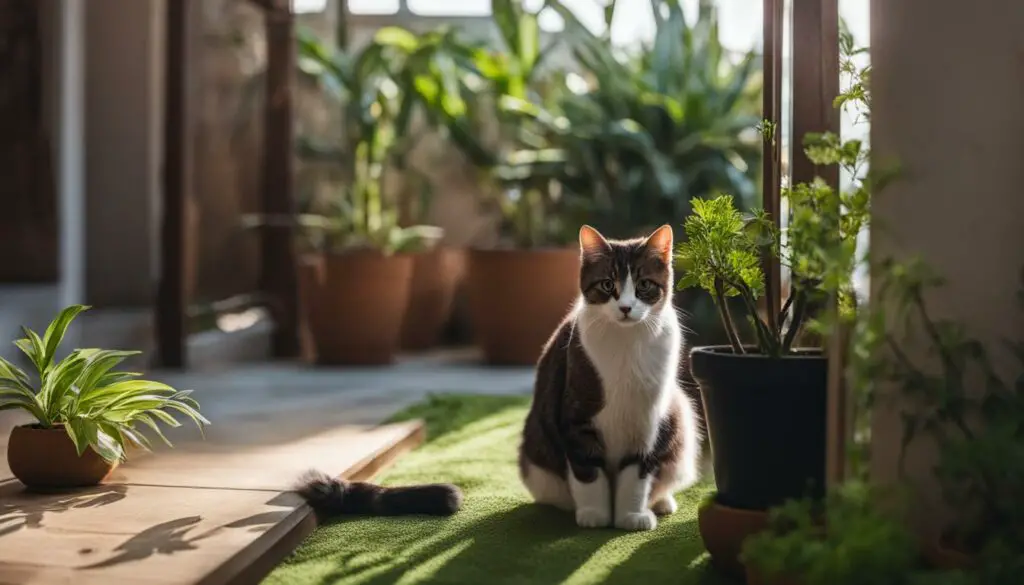
Techniques for Disciplining Your Cat
When it comes to disciplining your cat, it’s important to focus on positive reinforcement and redirecting their behavior. Punishment is not an effective or humane approach. Instead, try using voice and noise to deter unwanted behavior. Using a sharp “no” or clapping your hands can startle your cat and redirect their attention. Additionally, you can use a spray bottle filled with water as a deterrent.
Redirecting Behavior
Redirecting your cat’s behavior is essential in teaching them what is acceptable and what is not. If you catch your cat in the act of pooping in a potted plant, gently pick them up and place them in their litter box. This will reinforce the idea that the litter box is the appropriate place for elimination. You can also place a scratching post near the potted plants to give your cat an alternative outlet for their natural behavior.
Positive reinforcement is another effective technique for disciplining your cat. When your cat uses the litter box instead of the potted plants, reward them with praise, treats, or affection. This positive reinforcement will encourage them to continue using the litter box and discourage them from pooping in the plants.
Using Voice and Noise
In addition to redirecting behavior, using your voice and noise can be a powerful tool in disciplining your cat. Cats have sensitive hearing, so a loud noise or clap can startle them and interrupt undesirable behavior. Just be sure not to shout or use harsh or threatening language, as this can create fear and anxiety in your cat.
Remember, consistency is key when disciplining your cat. Establish clear boundaries and consistently enforce them. With patience and positive reinforcement, you can effectively teach your cat to avoid pooping in your potted plants.
How to Address Specific Behaviors
When it comes to disciplining a cat, it’s important to address specific behaviors with targeted strategies. Here, I will provide effective techniques for handling common cat behaviors such as biting, attacking, inappropriate elimination, inter-cat aggression, and disciplining kittens. By understanding the underlying causes of these behaviors and implementing appropriate discipline methods, you can create a harmonious environment for both you and your feline friend.
Biting
Biting is a natural behavior for cats, but it can become a problem when directed towards humans or other pets. To discourage biting, it’s important to provide appropriate outlets for your cat’s aggression. Engage your cat in interactive play sessions using toys that simulate prey-like movements. This will help redirect their biting behavior onto toys rather than people. Additionally, ensure your cat has a designated scratching post to help release excess energy and maintain healthy claws.
Attacking
Aggressive attacks are often a result of fear, stress, or territorial issues. If your cat displays aggressive behavior, it’s essential to identify and address the underlying cause. Provide a safe and secure space for your cat to retreat to when they feel threatened. Implement positive reinforcement techniques such as rewarding calm behavior and ignoring aggressive behavior. If the aggression persists, consult with a veterinarian or a professional animal behaviorist for further guidance.
Inappropriate Elimination
Inappropriate elimination, such as peeing or pooping outside the litter box, can be a frustrating issue. Start by ensuring the litter box is in a quiet, accessible location and cleaned regularly. If your cat continues to eliminate outside the litter box, consult with a veterinarian to rule out any underlying medical conditions. Additionally, consider using pheromone sprays or diffusers to create a calming environment for your cat and discourage them from eliminating in inappropriate areas.
Inter-Cat Aggression
Inter-cat aggression can occur when introducing a new cat to the household or when there is conflict between existing cats. Gradually introduce new cats to each other, allowing them to become familiar with each other’s scent before face-to-face interactions. Provide separate resources such as food, water bowls, and litter boxes for each cat to avoid competition. If the aggression persists, seek advice from a veterinarian or animal behaviorist to develop a behavior modification plan.
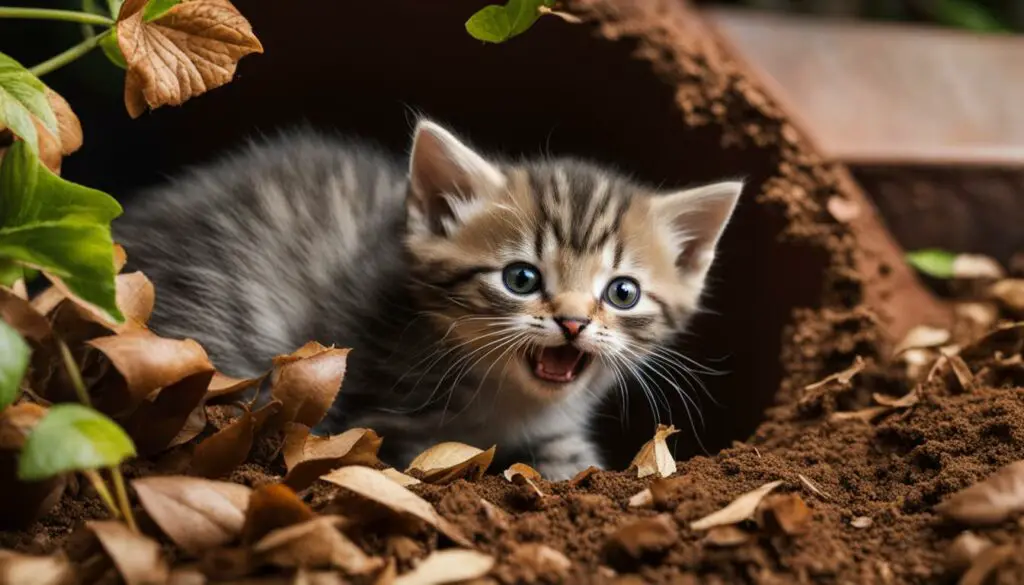
Disciplining kittens requires a different approach compared to adult cats. Focus on positive reinforcement techniques, rewarding desired behaviors with treats or praise. Provide plenty of toys and engage in interactive play to redirect their energy and prevent destructive behavior. Use gentle deterrents such as hissing sounds or a spray bottle filled with water to discourage unwanted behaviors. Remember, consistency and patience are key when disciplining kittens, as they are still learning and developing their behaviors.
| Behavior | Techniques |
|---|---|
| Biting | Redirect biting onto toys during play sessions |
| Attacking | Identify and address underlying causes of aggression |
| Inappropriate Elimination | Ensure a clean litter box and consult with a veterinarian if necessary |
| Inter-Cat Aggression | Gradually introduce cats and provide separate resources |
| Disciplining Kittens | Focus on positive reinforcement and gentle deterrents |
What Not to Do When Disciplining Your Cat
When it comes to disciplining your beloved feline friend, it’s important to avoid certain methods that can be harmful and ineffective. Physical punishment, shouting, and locking cats in a room are not recommended forms of discipline and can lead to negative consequences.
Physical punishment, such as hitting or kicking your cat, may cause fear, anxiety, and aggression. Cats do not understand physical punishment as a form of discipline and it can damage the trust between you and your pet. Instead, focus on positive reinforcement techniques that reward good behavior and redirect unwanted behavior.
Shouting or yelling at your cat can also have negative effects. Cats have sensitive hearing and loud noises can stress and scare them. It’s better to use a calm and assertive tone when communicating with your cat. Remember, they respond better to positive reinforcement and consistent training.
Locking cats in a room as a means of punishment is not effective and can lead to increased stress and anxiety. Cats need their own safe spaces and confinement can make them feel trapped and threatened. Provide alternative solutions for unwanted behavior, such as redirecting their attention to appropriate toys or scratching posts.
Remember, discipline should be based on positive reinforcement, consistency, and patience. Understanding your cat’s behavior and using effective training techniques will help create a harmonious environment for both you and your furry friend.
Table: Comparison of Discipline Methods
| Discipline Method | Effectiveness | Potential Consequences |
|---|---|---|
| Physical Punishment | Not effective | Fear, anxiety, aggression |
| Shouting | Not effective | Stress, fear, avoidance |
| Locking in a Room | Not effective | Increased stress, anxiety |
| Positive Reinforcement | Effective | Improved behavior, trust, bonding |

Using positive reinforcement techniques, such as rewarding good behavior with treats or praise, is a much more effective and humane approach to cat discipline. Cats respond well to rewards and encouragement, and it strengthens the bond between you and your pet.
Remember, every cat is unique and may require different methods of discipline. It’s important to be patient, consistent, and understanding while training your cat. By avoiding physical punishment, shouting, and locking in a room, you can create a loving and respectful relationship with your feline companion.
The Role of Vet and Dietary Considerations
When addressing cat behavior issues, it is important to consider the role of veterinary consultations and dietary considerations. Consulting a vet can provide valuable insights into your cat’s health and behavior. In some cases, certain medical conditions or underlying health issues may contribute to behavioral problems, including the tendency to poop in potted plants.
Veterinary consultations can help identify any underlying health issues that may be influencing your cat’s behavior. Conditions such as urinary tract infections, gastrointestinal problems, or digestive imbalances can cause discomfort and lead to inappropriate elimination behaviors. By addressing these health concerns, you can help improve your cat’s overall well-being and reduce the likelihood of potted plant accidents.
Furthermore, a cat’s diet plays a crucial role in their behavior. Nutritional imbalances, food allergies, or sensitivities can contribute to gastrointestinal discomfort, leading to undesirable elimination behaviors. Ensuring that your cat is on a balanced and appropriate diet can help address these issues and promote better overall behavior.
Remember, every cat is unique, and what works for one may not work for another. That is why it is essential to consult with a veterinarian to assess your cat’s individual needs and develop a tailored approach to address their behavior concerns. By prioritizing your cat’s health and diet, you can take significant steps to discourage them from pooping in your potted plants.

The Importance of Patience
When it comes to disciplining cats, patience is an essential virtue. Cats are unique creatures with their own set of instincts and behaviors, and changing those behaviors takes time. It’s important to remember that discipline is not about punishment, but rather about teaching and guiding your cat towards more acceptable behaviors. The learning curve for both you and your cat may be steep, but by embracing the process, you can create a positive and effective environment for discipline.

Embracing the process means understanding that cats learn at their own pace. What works for one cat may not work for another, so it’s essential to be patient and willing to adapt your approach. Consistency is key, as cats thrive on routine and repetition. By consistently reinforcing desired behaviors and redirecting unwanted ones, you can help your cat understand what is expected of them.
Creating a Supportive Environment
In addition to patience, creating a supportive environment can greatly aid in the discipline process. Provide your cat with appropriate outlets for their natural behaviors, such as scratching posts and toys. This helps redirect their energy away from unwanted behaviors like pooping in potted plants. Additionally, make sure your cat’s litter box is easily accessible and kept clean, as cats are more likely to use it when it is in a convenient location.
Remember, discipline should always be based on positive reinforcement. Praise and reward your cat when they exhibit desired behaviors, and avoid punishment or negative reinforcement, as this can lead to fear and aggression. By being patient, understanding, and consistent, you can effectively discipline your cat and foster a harmonious relationship.
| Benefits of Patience in Cat Discipline | Impact |
|---|---|
| Creates a positive learning environment | Helps cats understand expectations and desired behaviors |
| Reduces stress for both you and your cat | Allows for a more harmonious relationship |
| Fosters trust and respect | Strengthens the bond between you and your cat |
Case Study: Successful Cat Discipline in Action
In this section, I will present a real-life case study that highlights the effectiveness of cat discipline techniques. This case study will provide practical examples and insights into how discipline methods can be applied successfully to prevent cats from pooping in potted plants.
Meet Molly, a mischievous tabby cat who had a habit of using her owner’s plant pots as her personal litter box. Molly’s owner, Sarah, was frustrated and determined to find a solution. She tried various deterrents and training methods but saw little success.
After consulting with a cat behavior expert, Sarah implemented a combination of techniques. Firstly, she established clear boundaries by placing plant barriers around her potted plants. She consistently reinforced these boundaries with positive reinforcement, rewarding Molly with treats and praise whenever she used the designated litter box instead of the plant pots.
In addition to establishing boundaries, Sarah used redirecting techniques to discourage Molly from pooping in the pots. Whenever Molly showed signs of using the pots, Sarah would gently redirect her to the litter box and praised her when she used it. This technique helped Molly understand the desired behavior and reinforced positive habits.
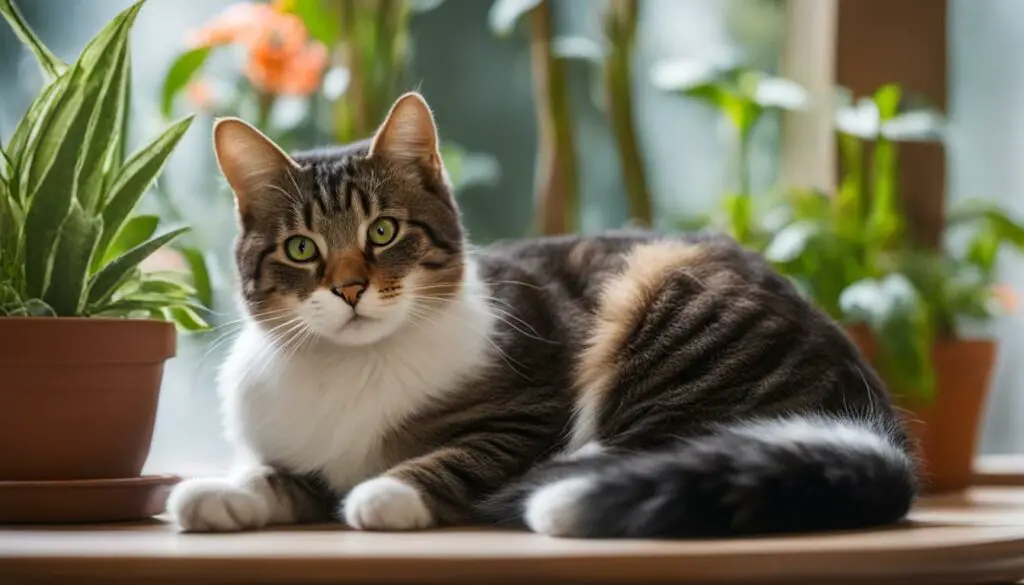
Over time, Molly’s behavior improved significantly. Through patience, consistency, and understanding of cat behavior, Sarah successfully disciplined Molly and prevented her from pooping in the potted plants. This case study serves as a testament to the effectiveness of positive reinforcement and boundary-setting when it comes to cat discipline.
Dispelling Common Cat Discipline Myths
When it comes to disciplining cats, there are several myths that need to be dispelled. Contrary to popular belief, cats can indeed be trained. While they may not respond to commands in the same way as dogs, they are capable of learning and adjusting their behavior. Punishment, on the other hand, is not the best way to discipline a cat. Cats do not respond well to physical or verbal punishments, which can lead to fear and aggression rather than positive behavior change.
Another common misconception is that cats behave badly out of spite. In reality, cats act based on their instincts and needs, and their behavior is not driven by a desire to intentionally upset their owners. Understanding and addressing the underlying reasons behind certain behaviors can help resolve them more effectively.
Lastly, it’s important to note that cats do not inherently know when they’ve done something wrong. Unlike humans, they do not possess a sense of morality or guilt. Punishing a cat after the fact can be confusing for them and may not have the desired effect. Instead, it’s important to focus on positive reinforcement and redirecting their behavior towards more appropriate alternatives.
Debunking the Myths
Now that we’ve debunked these common myths, let’s delve deeper into the most effective ways to discipline cats. By understanding their behavior, utilizing positive reinforcement techniques, and maintaining patience and consistency, we can create a harmonious environment for both cats and their owners.
| Myth | Reality |
|---|---|
| Cats can’t be trained | Cats are trainable, but they require patient and consistent training methods. |
| Punishment is the best way to discipline a cat | Punishment can lead to fear and aggression, positive reinforcement is more effective. |
| Cats behave badly out of spite | Cats’ behavior is driven by instincts and needs, not spite. |
| Cats know when they’ve done something wrong | Cats do not possess a sense of guilt or morality, so punishing them after the fact is ineffective. |
Key Takeaways on How to Discipline a Cat
Disciplining a cat requires a careful balance of patience, understanding, and positive reinforcement. By following these key takeaways, you can effectively address unwanted behaviors without resorting to harmful methods.
1. Use Positive Reinforcement:
Instead of punishing your cat for unwanted behavior, focus on rewarding and reinforcing good behavior. This can be done through treats, praise, or interactive play sessions. Positive reinforcement helps your cat associate desirable actions with positive outcomes, creating a stronger bond and encouraging repeat behavior.
2. Be Patient:
Cat behavior takes time to change, so it’s important to be patient throughout the disciplining process. Understand that cats have their own unique personalities and learning curves. Allow them time to adapt and respond to your training efforts, avoiding frustration or impatience.
3. Understand Cat Behavior:
Cats have innate instincts and behaviors that drive their actions. By understanding these behaviors, such as marking territory or scratching, you can address the underlying causes of unwanted behavior. This understanding allows you to tailor your discipline techniques to suit your cat’s individual needs.
Remember, disciplining a cat is not about dominating or punishing them, but rather guiding them towards more appropriate behaviors. With patience, positive reinforcement, and a deep understanding of cat behavior, you can successfully discipline your cat and create a harmonious environment for both you and your feline companion.
Conclusion
In conclusion, understanding cat behavior is crucial when it comes to disciplining our furry friends and preventing them from pooping in potted plants. By recognizing their natural instincts and behaviors, we can develop effective discipline techniques that are based on positive reinforcement, consistency, and patience.
Discipline methods should focus on redirecting their behavior, establishing boundaries, and using deterrents such as plant barriers. It’s important to avoid harmful and ineffective disciplinary methods, such as physical punishment or shouting, which can lead to fear and aggression.
Remember, discipline is a process that requires time and patience. By embracing the learning curve and maintaining a positive approach, we can successfully modify cat behavior and create a harmonious environment for both our pets and our precious potted plants.
In summary, cat discipline methods should be rooted in a deep understanding of cat behavior, utilizing positive reinforcement, and practicing patience. By implementing these techniques, we can ensure that our cats refrain from using our plant pots as their personal litter boxes, allowing us to enjoy a thriving garden without any unwanted surprises.
FAQ
Why do cats poop in potted plants?
Cats have natural instincts and behaviors that drive them to mark territory and use specific areas for elimination. They may see your potted plants as an attractive place to do their business.
How can I prevent cats from pooping in my potted plants?
There are several effective strategies you can try, such as establishing boundaries, using plant barriers, and disciplining your cat with positive reinforcement techniques.
What are some common cat behavior problems that contribute to this issue?
Inappropriate scratching, territorial marking, and the use of catnip are common cat behaviors that may lead to cats pooping in potted plants.
How can I establish boundaries to deter cats from using my potted plants?
Consistency is key. You can set clear boundaries by using plant barriers, such as chicken wire or rocks, to prevent cats from accessing your potted plants.
What techniques can I use to discipline my cat and redirect their behavior?
Positive reinforcement, redirecting negative behavior, using voice and noise, and the debate surrounding the use of spray bottles as a deterrent are all techniques you can try.
How can I address specific cat behavior problems?
This section provides strategies for addressing biting or attacking, inappropriate elimination, inter-cat aggression, and disciplining kittens.
What disciplinary methods should I avoid?
Physical punishment, shouting, and locking cats in a room are not effective forms of discipline and can lead to fear and aggression.
When should I consult a vet for cat behavior issues?
If you’re experiencing persistent behavior problems, it’s a good idea to consult a vet to rule out any underlying health issues that may be contributing to your cat’s behavior.
How does a cat’s diet impact their behavior?
A cat’s diet can play a role in their behavior. This section explores how dietary considerations can influence their behavior.
What role does patience play in disciplining cats?
Patience is key when disciplining cats. Understanding the learning curve and embracing the process will help maintain a positive and effective approach to discipline.
Can you provide a real-life case study of successful cat discipline?
Yes, this section presents a real-life case study that provides practical examples and insights into how discipline techniques can be applied effectively.
What are some common myths about cat discipline?
This section dispels common misconceptions such as cats can’t be trained, punishment is the best way to discipline a cat, cats behave badly out of spite, and cats know when they’ve done something wrong.
What are the key takeaways on how to discipline a cat?
The key takeaways include the importance of positive reinforcement, patience, and understanding cat behavior in the discipline process.








